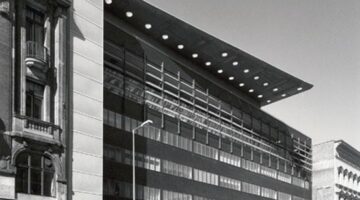
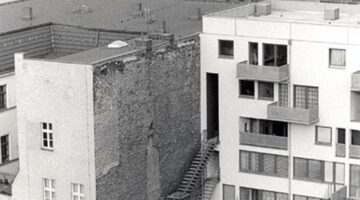
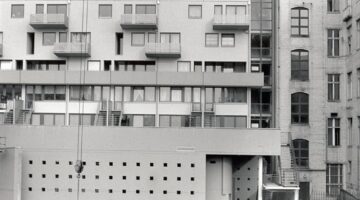


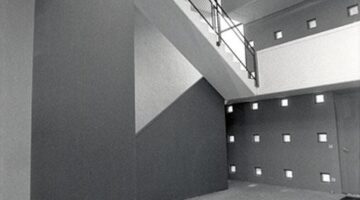
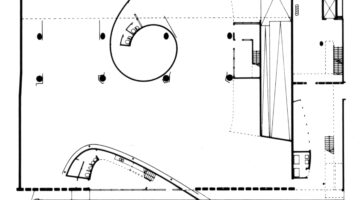
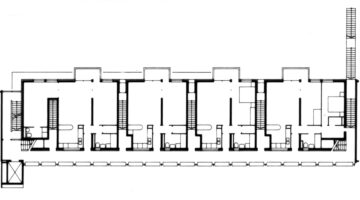
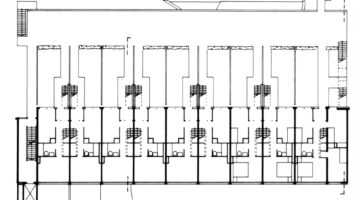

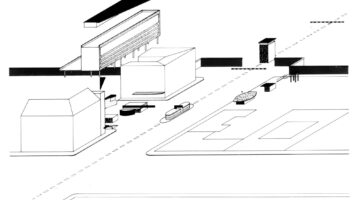
Checkpoint Charlie Housing
Main objectives of the project
Date
- 1989: Construction
Stakeholders
- Architect: OMA ( Office for Metropolitan Architecture )
Location
City: Berlin
Country/Region: Berlin, Germany
arquitecto











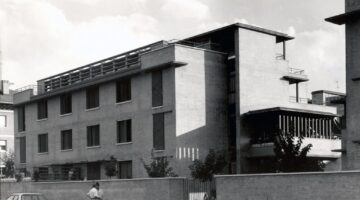
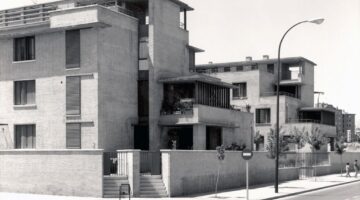
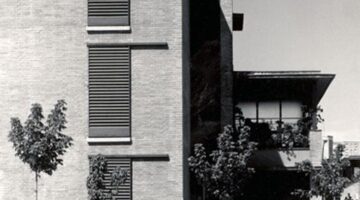
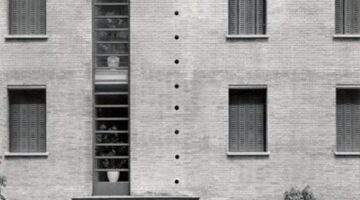

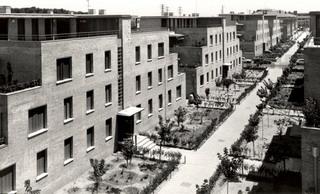
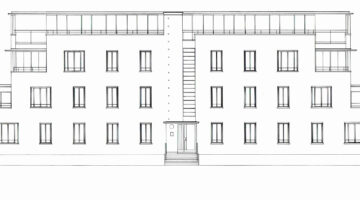
A group of low-rise housing blocks in an area of new development of Madrid.
When the project was drawn up, the area was not even partially urbanized. This made it possible to treat the site with a degree of autonomy, erecting low-rise buildings (three-storey high) spread evenly over the entire area, unlike the high-rise developments nearby. This autonomy was taken as far as possible. Fences and railings define the outer perimeter, making a clear public-private divide, creating an area in which to locate the buildings.
The houses were to be small and low-rise. This fact, along with the requirement of combining different housing programs, led to unique design problems. The idea was to avoid the somewhat harsh architectural styles often associated with the suburbs, and substitute them with a more user-friendly architecture, more concerned with certain ideas of comfort and welfare. The architects did not want the blocks to be traditional boxes, but created shapes which present different facets as one moves around them. Special attention was paid to the lateral headwalls where the blocks meet, so that what might have been mere consequence -the gap between the blocks- could also be understood, paradoxically, as having originated the design.
-
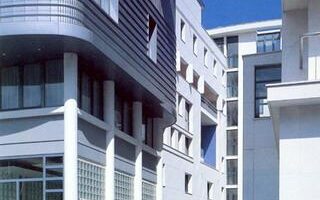
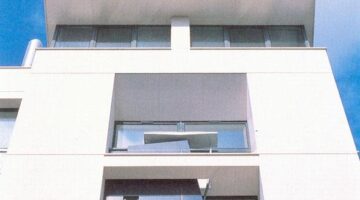
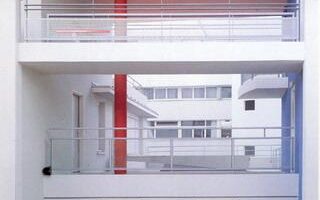
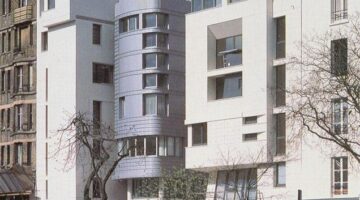

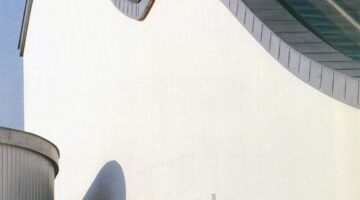
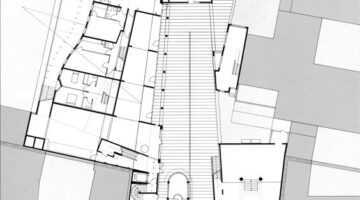

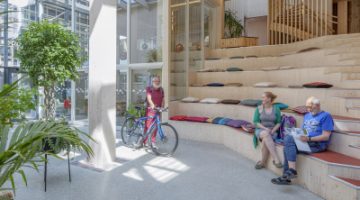
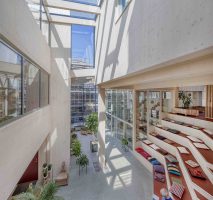
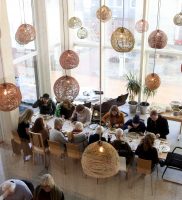

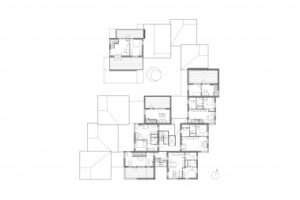
Vindmøllebakken is a housing community in Stavanger that embodies the concept of Gaining by Sharing, emphasizing collective sharing over private ownership. The development consists of 40 Co-housing dwellings, 4 townhouses, and 8 apartments, all constructed from solid timber. The design prioritizes communal spaces, with a spacious internal courtyard and a central double-height living room as the heart of the complex. By minimizing private living units, residents have increased access to shared facilities like a communal kitchen, workshops, library, and guest apartments.
User participation has been crucial throughout the project, with future residents involved from conception to construction. The design choices promote sharing and caring for neighbors, aligning with the principles of the Gaining by Sharing model. The housing model aims to create a socially sustainable urban living environment by fostering community support and sharing. The diverse mix of dwelling types accommodates residents of different ages and life situations. The spatial organization centers around a central courtyard, with family rooms and common spaces positioned towards the middle, providing ample natural light and ventilation through roof terraces and balconies.
The timber structure features diffusion-open pre-fabricated panels with hemp insulation, creating a comfortable indoor climate by regulating moisture and emissions. The use of sedum roofs and recycled materials from existing industrial buildings in the external landscaping further contributes to the natural and green aesthetics of the community. The holistic approach to construction and material composition reflects equal importance given to both architectural design and social sustainability at Vindmøllebakken.
Gaining by Sharing, a housing model concept based on owning less privately but sharing more collectively, forms the underlying framework behind Vindmøllebakken housing community. A project that questions how we build socially sustainable living spaces that reduce our carbon footprint and improve the quality of life. Vindmøllebakken housing development sits in the Eastern district of Stavanger, a neighbourhood with a diverse mix of historic industrial buildings and traditional timber dwellings. The new proposal combines 40 Co-housing dwellings that share 500m2 of communal space and facilities, with 4 townhouses and 8 apartments also incorporated into the scheme.
The project is constructed from solid timber and orientated in plan around a spacious, internal courtyard and a double height living room that has become the beating heart of the breathing, all-wooden complex. Through an efficient spatial organisation, private living units are minimized with smaller kitchens and bathrooms. Residents therefore gain more access to shared facilities such as a communal kitchen, workshops, library and guest apartments. Residents own less but have access to more.
User participation has been critical throughout the project with the user group being involved from conception through to the design and construction process. A common understanding of community living has been developed among the future residents, but also together with us as the architect. This process has formed and grown alongside the principles of the Gaining by Sharing model, together with Indigo Vekst and Gaia Trondheim. Architectural design choices that support sharing with, and caring for one another’s neighbour, sit at the heart of the project. We believe in the potential of this housing model in creating a more socially sustainable way of urban living by supporting and sharing with one another’s neighbour. Designed for a diverse mix of resident demographics, different dwelling types are incorporated to suit multiple ages and life situations. Organised spatially around the central courtyard, family rooms and top lit common spaces are located towards the middle of the site. The dwelling units are stepped and shaped around the courtyard and atrium to provide roof terraces and balconies increasing access to natural daylight and ventilation.
The timber structure is formed by diffusion-open pre-fabricated panels with hemp insulation and a 6cm thick solid timber board as the internal finish. This exposed natural surface creates a comfortable indoor climate quality by naturally regulating moisture and emissions. The double height spaces maximise natural daylight into the depth of the plan allowing areas for internal planting to contribute the internal climate quality of the apartments and shared spaces.
Sedum roofs contribute to the natural and green areas within the built environment of the city and create a low maintenance finish to the roofscape. The external landscaping has also been carefully considered with materials from the existing industrial buildings on the site being recycled and re-used. Bricks, concrete beams and roof girders have been incorporated into internal details and finishes and external retaining walls. This holistic approach towards the construction and material composition of the architecture has been as important as to the design as the considerations to the social sustainability at Vindmøllebakken.

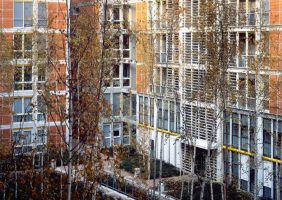


This building is situated in a densely populated area of Paris. Its rectangular shape integrates with the surrounding urban fabric, but its center features a carved-out interior green space. The building is divided into three sections by narrow slots, with the garden creating a surprising contrast to the bustling street. Residents access their building entrance by walking through the garden, adding to the element of surprise. The building offers a variety of apartment sizes and layouts, with model apartments designed to be flexible and neutral. Each of the 220 apartments has two exposures, overlooking both the garden and the urban neighborhood.
The building is located in a densely populated area of the 19th arrondisement in Paris. The building, with a rectangle general shape, can be thought of as a mass built to fit into the existing urban fabric on its outside perimeter while its center has been "carved out" to accommodate an interior green space. Two narrow slots divide the constructions in there sections on the garden. The contrast between the bustle of the street and the calm of the garden creates hence, an effect of surprise for the residents who must walk through the garden to reach their building entrance. The volumetric diversity of the building results in a wide variety of apartments. However, for the buildings bordering the garden and for the blocks on the east and west separated by the slots, model apartments with fairly neutral and flexible layouts were created.
Essentially they comprise a large crosswise room facing north-south with a balcony or winter garden at either end; a conventional “night” area is adjacent. Therefore each apartment of the 220 created, has two exposures: the garden and the urban neighbourhood.
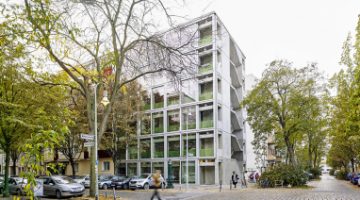
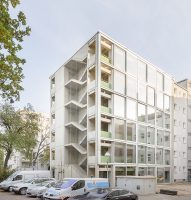
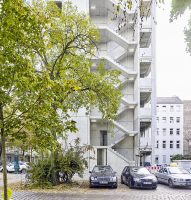
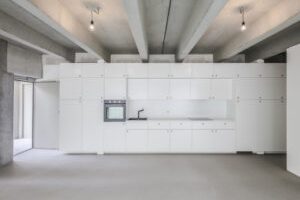

"Wohnregal" is a 6-story structure in Berlin that houses affordable live/work ateliers. It utilizes pre-fab concrete elements commonly found in industrial construction, providing cost and time savings. The ateliers have varied layouts thanks to the absence of interior structural walls, and sliding glass doors on the east and west façades can be opened to create a loggia-like environment. The building promotes a diverse range of lifestyles and addresses the complexity of inhabitation often overlooked in serial construction. With its efficient construction and adaptable design, it offers long-term resilience and potential for repurposing. The absence of mechanical climate control is compensated by natural ventilation, contributing to a comfortable living environment.
“Wohnregal” houses life/work ateliers. It´s based on pre-cast concrete elements common in industrial construction and bridges two challenges. It applies serial construction to save cost and time. At the same time it counters preconceptions that seriality always implies uniformity of the units thus addressing an ever broadening scope of lifestyles.
The term Wohnregal translates into “habitable rack”. It is a 6-story structure based on pre-fab concrete elements commonly used in industrial construction. The rack houses affordable ateliers which are renegotiating the relationship of live and work environments. There are two units per floor – oriented east and west. An open staircase along the north façade provides access. The ateliers vary greatly between 35 and 110 sqm. Thanks to the principle of the pre-fab rack spanning from façade to façade without interior structural walls they can each have a different plan layout. Sliding doors appropriated as a curtain wall constitute the east and west façades. They allow for the interior to be opened up during the summer, allowing natural ventilation turning the interior spaces into loggias. The building is situated in a corner lot in Berlin Moabit left unbuilt since the war.
“Wohnregal” uses pre-cast concrete elements common in industrial construction. It bridges two contradictory challenges of the Berlin housing market. Pre-fabrication offers cost and time savings thus addressing the rising construction cost. Countering preconceptions that serial construction always implies a standardization of the units themselves, the project offers a wide range of different live/work ateliers for an ever-broadening scope of life styles. The ceilings spanning between the facades without any interior structural support enable this flexibility.
Prefabrication in housing has been a century-long story of optimization, and has had a continuous up and down of promises stated and promises broken. The “Wohnregal” takes into consideration this contradictory history of prefabricated construction. It re-appropriates the DNA of the prefabricated warehouse which has taken the approach of optimization to its absolute limits. While exploiting that very economy it also reinterprets its structural openness to introduce a discourse that has been strangely absent in the focus on prefabrication: the complexity and variety of inhabitation. The industrial construction of the “Wohnregal” consists of pillars, beams and TT-ceilings. The latter span from façade to façade economically. All interior walls are built using drywall construction. The lack of any structural members in the interior allows for different layouts an every floor. The construction is very economical (1500 EUR/sqm) and fast (6 weeks for the assembly of the complete prefab structure).
The curtain wall consisting of sliding glass doors allows for the interior to be opened up to its surroundings during the spring and summer months, turning the living space into a loggia-like environment. There are no means of mechanical climate control in the building, as the natural breeze creates a comfortable climate even during summer days.
The rack structure of the “Wohnregal” offers a great degree of long-term resilience. The interior can be repurposed for different uses in the decades to come. This openness implies a longevity and thus sustainability of the structure. Almost all components of the building have been mechanically connected. In the case of the future disassembly all materials can be separated out and become part of a circular economy.
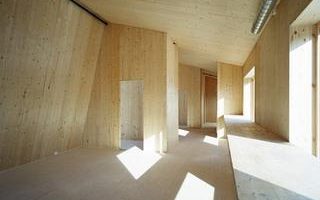
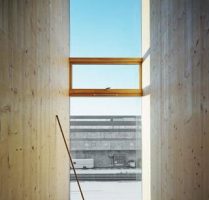
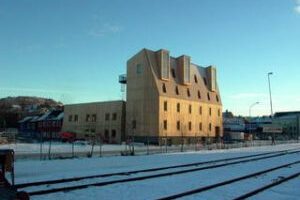
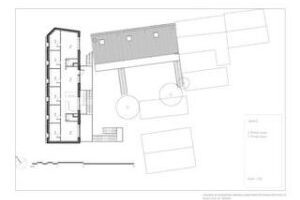
In Trondheim, Norway, the project aims to provide ample light and views for residents in the Svartlamoen neighborhood. Originally an industrial zone, it was rezoned for residential use as part of an ecological urban development initiative. A competition was held for an innovative wood-based residential building, resulting in a sustainable design with shared facilities, compact solutions, and flexible spaces. The project comprises two buildings: a five-story block with commercial space on the ground floor and shared flats above, and a smaller volume with single-room flats. The structures feature untreated timber components, providing column-free spaces.
How to give the greatest amount of light and the best view to the largest number of residents. Located in Trondheim, Norway’s third largest city, the site for the project is a rather run-down area called Svartlamoen that was established in the 18th century as an outlying working-class neighbourhood. Although it was rezoned for industrial use in 1947, all plans for such development were scrapped in 2001 when it was rezoned once again, this time for residential use. All city-owned property in Svartlamoen was transferred to a new foundation. The aim is to develop the area as an example of ecological urban development, with low-cost housing.
During this period, an initiative by the residents led to an open competition for a new residential building that would full this objective. Moreover, the competition called for innovative solutions for the use of wood in an urban context.
Consequently, the design strategy was based on shared facilities; compact solutions; simple detailing as well as a high level of flexibility with respect to possible future changes in the programme resulting in a sustainable project with an economical total build price.
The project consists of two buildings with a total of 1030 m². The largest volume is a five-storey block with commercial space on the ground floor and shared flats for five to six people on the other four floors. While the bedrooms are compact and oriented toward the north, the communal spaces face the backyard on the south side which is characterised by large windows and an external staircase. On the top floor, the bedrooms are even more compact, thereby increasing the size of the communal space. The smaller volume contains small single-room flats.
All the structural members are untreated massive timber pieces that are factory produced and assembled on site. Only the exterior wall elements are load bearing, providing a column-free space on each storey.




The VM Houses, located in Ørestaden, Copenhagen, are a residential project designed with a distinct V and M shape. The buildings are strategically twisted and turned to maximize views and eliminate obstructed sightlines between blocks. The V house features balcony condos, while the M-house offers a modern take on Le Corbusier's Unite dhabitation with improved circulation and views. The unique wedge-shaped balconies on the south facade create a sense of community and connection among neighbors. With over 80 unique apartment types out of 225 units, the complex composition of the VM Houses resembles a three-dimensional game of Tetris. The buildings showcase large glass facades, elegant wood framing, solid oak wood floors, and white concrete walls and ceilings. Extensive daylight simulations were conducted to optimize views and solar orientation, ensuring every unit receives direct sunlight throughout the year.
The VM Houses, shaped like a V and an M when seen from the sky, is the first residential project that was built in the new district of Copenhagen known as Ørestaden. Through a series of transformations the block is opened up, and twisted and turned to ensure maximum views of the surrounding landscapes and suburbs, as well as eliminate the vis-a-vis between the blocks.
The V house is conceived as a balcony condo, the M-house as an Unite dhabitation version 2.0. But where Le Corbusier designed narrow flats surrounding hundreds of meters of dead end corridors, the zigzagging of the M-house ensures that all corridors have views and daylight in both directions. These openings transform the circulation into an attractive social space. For the south façade facing the park we designed a new type of balcony- a wedge shaped plane that combines minimum shade with maximum cantilever. On a warm summer afternoon, the wall of balconies form a vertical backyard community, creating connections to neighbours in a vertical radius of 10m. As a result of the zigzagging, stepping, sloping, intricate circulation and multilevel apartments, the VM houses are populated by a swarm of different apartments. Out of 225 units there are more than 80 unique types. The many multilevel apartment types interlock in complex compositions on the façade, transforming the exterior of the VM houses in to a three dimensional game of Tetris.
The VM Houses are made up of simple but exquisite materials with large glass facades framed by fancy wood. Floors are made up of solid oak wood, and dark, hard wood have been used for the balcony floors. Walls and ceilings appear with a somewhat raw finish in white concrete, and all internal stairs and handrails come in white painted steel. All the apartments’ external walls are made up of glass.
To ensure that the VM shape was optimal with respect to views and solar orientation, a number of daylight simulations were made simulating light at different times of day and year. By using the studies we were able to design a building with 225 units where all are guaranteed direct sunlight, everyday throughout the year.
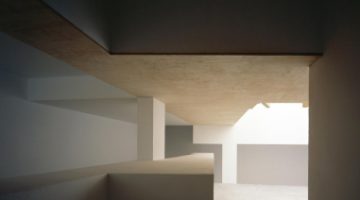
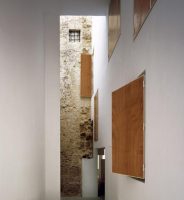

The programme was to rehabilitate an old building with multiple historical layers in the centre of Cádiz, which was already occupied by several families.In order to provide these families with decent housing while at the same time conserve the morphology of the building, the design strategy focused on the refurbishment of the ground and first floors, above which the new architecture took shape. Other conditioning factors such as maintenance of the net floor area and the facade height, led to the development of five apartment units with space for the neighbourhood association on the ground floor and set-back attic additions on the roof. An offshoot of the building that connects to the plaza adjacent to the cathedral has recuperated its street-like character and is now a two-storey private street, which like the patio, has large windows of varying shapes and sizes with movable plywood shutters, creating an interior urban landscape.